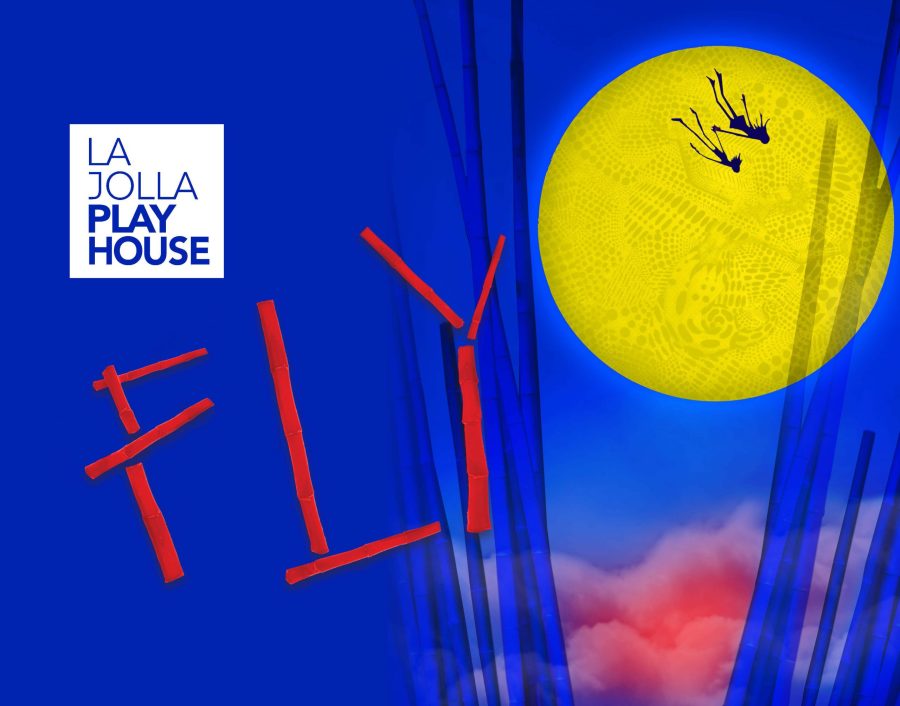While “Fly” entertains with stunning visuals, it fails to achieve the emotional depth it strives for.
Walking into the Mandell Weiss Theatre on a Wednesday night, I was unaware that I would be part of the last audience to see “Fly” at the La Jolla Playhouse. The following evening, on Thursday, March 12, La Jolla Playhouse canceled its remaining performances to adhere to COVID-19 pandemic gathering guidelines. I fondly remember this experience as part of the last night of normalcy the San Diego community would see for some time, and I am grateful to have been a part of it.
“Fly,” a musical based on J.M. Barrie’s 1911 novel “Peter and Wendy” (known today as “Peter Pan”), swaps the classic tale of the Darling children and the famous boy in green for Wendy’s perilous journey of self-development in a strange, mystical land. The story begins with Wendy (Storm Lever), thirsting for both adventure and the ability to remain a child while in the confines of her bedroom. Lucky for her, Peter Pan (Lincoln Clauss) and Tinkerbell (Isabelle McCalla) crash through her window that night to whisk her off to Neverland, the magical home of The Lost Boys, a band of Pirates, and a beguiling, glamorous crocodile (Liisi LaFontaine).
The musical’s biggest strength was its creative interpretation of Neverland. The stage boasted a beautiful set, primarily shifting between the Lost Boys’ play structure of bamboo thickets and the pirates’ beaten up “bro cave” of a ship. The costuming was inventive — Peter Pan donned a survivalist outfit instead of his classic asparagus-like look, and the pirates were humorously styled as a band of misfits that meshed together. Furthermore, the ensemble’s artful anonymity as Neverland’s dancing foliage brought airs of mystery and whimsy to the stage. As for music, the animalistic, tribal sound of island drums were the heartbeat of Neverland. The crocodile, a looming spirit central to Wendy’s story, was its life-force. The lighting only added to the mystique and development of each scene, sometimes rippling across the stage as a blue lagoon or establishing mood with its color. The combination of thoughtful design elements produced a Neverland that was lively, immersive, and, above all, surreal.
While the show’s set, choreography, and Cirque-du-Soleil-esque aerials were sure to impress, there were parts of the storyline that felt underdeveloped. For instance, Wendy’s loving relationship with her dad was punctuated with one or two lines signifying her childish dislike of his statement that her “growing up” reminds him of her deceased mother. The audience was forced to buy that Wendy’s dislike of this comparison ties into her longing for exploration and everlasting youth. It felt slightly rushed, as if the story needed to justify the journey that was about to ensue but lacked sufficient stage time to do so. Considering Wendy’s closeness to her father, this motivation seemed out of place.
Additionally, Wendy’s reluctance to grow up fuels her decision to learn to fly from Peter, who teaches her that in order to soar through the air, one must forget everything they previously knew. After all, as the show demonstrates, memories are heavy and weigh a person down. While certainly an intriguing concept, this key point in “Fly”’s plot created inconsistencies that disserviced its otherwise promising story. At times Peter and Wendy were comically forgetful and at other times frustratingly aware of themselves and their surroundings after flying. Later on, the musical attempts to address this inconsistency through Tinkerbell with a line about Peter choosing to forget details at his convenience, but the explanation feels faulty. The resulting mix of scenes that both followed and rejected this fact of Neverland suggested that this idea, though compelling in theory, was not executed correctly.
Moreover, Wendy’s conflict over growing up or staying a child — summarized as “to forget and fly or to remember and stay grounded” — was a major theme in the story that was cheapened by the show’s resolution of having the characters use pixie dust to fly one last time. The mix of these actions felt like a feeble attempt to sew together explanations and solutions for convenience, and as flying is so central to the theme of the musical, I could not help but wish that the logic behind it had been more convincing.
While some plot points could be refined, “Fly” still had plenty of enjoyable moments due to its costuming, set design, and acting. The crocodile’s role was creatively reimagined in this interpretation as a central figure who certainly holds her own powerhouse vocals and energy opposite Wendy. The imagery related to the crocodile was stunning. I can still envision a certain scene involving a lavender backdrop and glittering emerald green tail. Captain Hook (Eric Anderson) had impeccable delivery and entertained with his song of lament over his lost hand. Peter engaged with his petulance, Wendy wowed with her vocals, and the cast members and ensemble enriched one another’s performance.
Overall, “Fly” stood out for its compelling visuals and strong cast but struggled to achieve emotional depth and a consistent storyline. Despite these pitfalls, this new take on an old favorite renews the spirit of Neverland for the musical stage, bringing to viewers a refreshing exploration of what it really means to “grow up.”
Rating: B
Opened: Feb 18, Mandell Weiss Theatre
Starring: Storm Lever, Lincoln Clauss, Eric Anderson, Liisi La Fontaine
Image courtesy of La Jolla Playhouse














